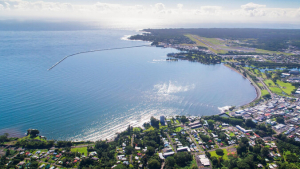
While many changes happened during the pandemic, one instance of change involving fishing around Hawaiʻi Island showed the importance of the activity for residents to researchers at the University of Hawaiʻi at Hilo, thanks to photos on social media.
The researchers were part of a team examining pandemic-driven changes in nearshore, non-commercial use of fisheries on Hawaiʻi Island. The study, “Pandemic-driven changes in the nearshore non-commercial fishery in Hawaiʻi: catch photos posted to social media capture changes in fisher behavior,” was published on March 28 in the PeerJ journal.
While studying new fishing habits that arose during the pandemic and how those changes were impacting local fisheries, the researchers also confirmed something interesting about data collection in the age of social media. Catch photos posted to Instagram told a story about changes in fishing behavior much more quickly than conventional approaches to data collection. The images showed that people were fishing more during the COVID-19 lockdown, and they started targeting different species than their normal catch.
The study’s lead author is adjunct associate professor of marine science Tim Grabowski, who is also unit leader at the U.S. Geological Survey’s Hawaiʻi Cooperative Fishery Research Unit in Hilo.
“This project illustrates the importance of nearshore fisheries to the people of Hawaiʻi Island as a source of both sustenance and recreation during a time of hardship, uncertainty and stress,” said Grabowski. “Not only were people fishing more during the COVID-19 lockdown, but they started targeting different species. From a management perspective, understanding how fishers change their behavior during hard times will allow better planning to ensure these resources are available to people when they are needed most.”
The study’s co-authors are Michelle Shuey, an instructor of geography and environmental science; Andrew Curley, an anthropology alumnus; Michelle Benedum, a political scientist and doctoral candidate from University of Colorado at Boulder; and Cole Dill-De Sa, an undergraduate student at Stanford University’s earth systems program. Curley and Dill-De Sa were able to participate in the study through UH Hilo’s Pacific Internship Programs for Exploring Science program.
Study highlights
The study produced three main takeaways. First, resource users (people fishing) posted to social media nearly three times as often during the pandemic with nearly double the number of fish pictured per post. Secondly, individuals who fished for subsistence were more likely to increase the amount of time spent fishing and relied more on their catch for food security. Lastly, individuals fishing exclusively for subsistence were more likely to fish for different species.
In addition to examining catch photos on social media, researchers also collected oral histories directly from fishers. Information gleaned from those interviews validated the social media findings, suggesting that social media can be used to rapidly collect data and predict changes in nearshore fisheries due to large-scale disturbances.

“Our analysis of photos posted to social media allowed us to quickly and efficiently detect many of the changes that occurred in the fishery that were only apparent after spending much more time and effort talking story with local fishers around Hilo Bay,” said Grabowski.
The researchers emphasize the importance of this quick data collecting—as climate change threatens additional disturbances, it will be necessary for resource managers to collect reliable data quickly to prevent unsustainable fishing pressures and to better target management plans.
“Climate change is only likely to increase the frequency and severity of acute social disruptions, like the COVID-19 pandemic,” said Grabowski. “Therefore, understanding how fishers respond to these disruptions is critical to ensuring that resource management can be responsive and adaptive to changing use patterns.”
To read more about the study, visit UH Hilo Stories.
—By Susan Enright

